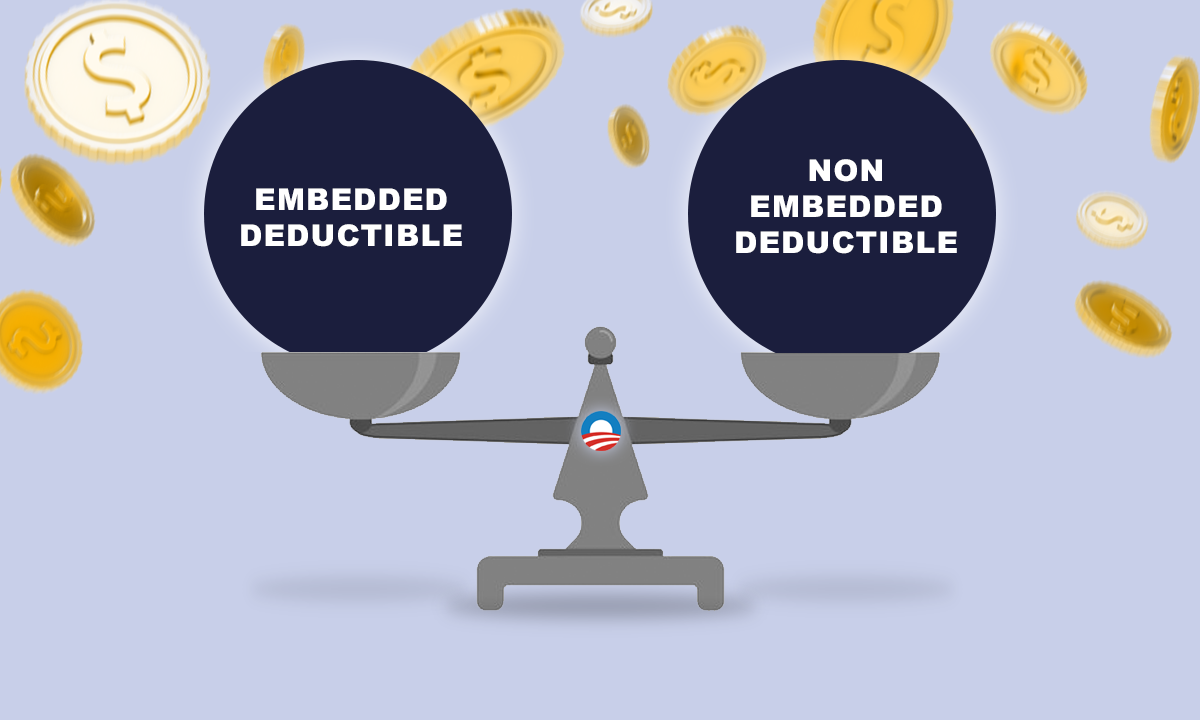In the world of health insurance mostly everyone knows about deductibles and the basics of how they work. But did you know that there are 2 types of deductibles? We will be focusing on how deductibles work inside the Affordable Care Act (Obamacare insurance). Learn everything from the different types to which one is better, and more with Cuspide. Let’s explore embedded vs non-embedded deductible in health insurance.
What does a deductible mean in health insurance?
A deductible in health insurance is like a certain amount of money you need to pay out of your own pocket before your insurance starts to cover part of the costs. To put it more simply, a deductible is what you must pay before your insurance helps you out. For most, the lower the deductible is, the better.
Example: Let’s say you have a health plan with a $500 deductible. If you get medical care and it costs $800, you’ll need to pay the first $500 (your deductible), and then your insurance will start to help cover the remaining costs according to your plan’s terms. (You could have copays or coinsurance after this as well.)
But it goes a little deeper than that. As some of you may know there are 2 different types of deductibles in health insurance. One is more common and is used inside the Affordable Care Act (Obamacare.) The other you won’t really find in the marketplace. Let’s dive further into both.
Embedded vs Non-Embedded Deductible differences
People usually ask, “What are the two types of deductibles?” and they must know that they are embedded and non-embedded. You must know that inside the ACA, the most common is the non-embedded deductible. This of course only applies once there are more than 2 people applying for coverage. The difference between these 2 types of deductibles as well as the different types of out-of-pocket maximums (which we will talk about later) are just as important.

Embedded deductible
An embedded deductible is applied to each individual getting coverage in the plan. Each person inside the plan must reach this deductible to have the insurance company kick in. (Look at the examples.) Other family members may still have to meet their own individual deductibles before their coverage kicks in. There may be private plans out there that work like this but, this is NOT how deductibles work inside the Affordable Care Act.
Embedded deductible example
For this example, we will use John and Mary, they are a couple with a $2,000 deductible.
Individual deductible: $1,000
John’s medical expenses: $2,000
Mary’s medical expenses: $500
As you can see, John has already met his deductible because he has had a $2,000 expense but Mary still has $500 worth of deductible to meet because she hasn’t reached the limit yet. In an embedded deductible, each person has their own individual amount that they must reach. It may be a more favorable choice for families who some members have more expenses than others. But this isn’t the case inside Obamacare.

Non-embedded deductible
A non-embedded deductible (also known as aggregate deductible) means it applies to the entire family or group. Once the total deductible amount for the family is met, the insurance plan begins to cover expenses for all family members, regardless of whether individuals have met their own deductible or not. This is how deductibles work in health insurance through the ACA marketplace.
Non-embedded deductible example
For this example, John and Mary still have a $2,000 deductible but this time it is non-embedded.
Family total deductible: $2,000
John’s medical expenses: $1,000
Mary’s medical expenses: $1,000
Both Mary and John together reached the total deductible so now they can have the insurance company help with paying their future expenses. Even if just, John reached the $1,000 deductible himself, both now have $0 deductibles. This is how deductibles work when you get Obamacare plans. There are different companies inside the ACA, but all deductibles will usually work like this.
Is an embedded or non-embedded deductible better?
A non-embedded is the most popular choice and is considered better because the deductible is met as a whole rather than individually. So, if there is a family of 3 and the deductible is $3,000 then once the deductible is reached (between the 3) the insurance company kicks in, rather than $1,000 per person. Also under a non-embedded deductible, only 1 person can reach it and the rest of the family members can enjoy the $0 deductible they now have. Some people like the embedded deductible system while others approve of the one that is in Obamacare. It is all up to you.
Get low deductible health plans with Cuspide!
80% of Cuspide clients have a $0 deductible health plan! Services like finding doctors, comparing plans, making payments, and more! Join our many happy clients today at (305) 970-8583.
Embedded vs Non-Embedded Deductible for Single Person
The best deductible for a single person is the lowest one possible. Just like a family plan, the more income you make, the more expensive low deductible health plans will be. When you are talking about a single person it does not matter whether it is embedded or non-embedded because this only applies to more than 1 person. When it is just 1 person, they either have a deductible that they must reach, or they don’t ($0 deductible).
How do family deductibles work in health insurance?
In health insurance, family deductibles work as a whole, which means that the deductible is shared amongst all the family members that have coverage. So, between all of them once they reach their deductible amount, the insurance company can help pay for their plan. (Although you still have your copays of course.) This is different than how out-of-pocket maximums work, and it is just as important as deductibles (more on this later).
Embedded vs Non-Embedded Deductible Marketplace Plans
Obamacare plans are made up of non-embedded deductibles. When shopping for medical plans you want to aim for the lowest deductible possible, that way you don’t have to pay a lot before the insurance company starts to help with expenses. The more money your household makes, the more it will cost in monthly premiums to find a low deductible health plan. We suggest contacting an insurance agent/broker (like us) to help you with deductibles in health insurance.

What does an embedded out-of-pocket maximum mean?
In an embedded out-of-pocket maximum, each individual within a family/group health insurance plan has their own maximum limit for out-of-pocket expenses. Once an individual reaches their personal out-of-pocket maximum, the insurance plan covers 100% of their medical expenses for the rest of the policy period.
For example, if it is a couple and the out-of-pocket max is $5,000 that means that each of them will have an OOPM of $2,500. Once one reaches their OOPM then they have everything covered, while the other still must reach theirs. This is how out-of-pocket max works in the ACA (Affordable Care Act.) A non-embedded out-of-pocket maximum does not exist inside Obamacare and may sometimes be only found in private plans. Although they are not as popular.
Frequently asked questions about deductibles
Cuspide answers the most asked questions regarding embedded and non-embedded deductibles. If you do not see your question asked here or have a specific one, contact us at Cuspide at (305) 970-8583.
When it comes to the topic of embedded vs non-embedded deductibles, you must know that aggregate is the same as non-embedded. Usually, aggregate deductible is better for most because it is a deductible that must be met (by the whole family/group in the health insurance plan.) Think of it like this: An aggregate deductible of $3,000 for a family of 3 means the 3 of them combined need to reach the $3,000 to have the insurance start helping. While an embedded deductible of $3,000 for a family of 3 means each one has a $1,000 deductible to meet.
Embedded family deductibles work by each person having their own deductible that they must meet. For example, if there are 2 people inside a health insurance plan with a family total deductible of $2,000 then they each must reach $1,000. When it comes to getting health insurance (through the ACA marketplace) there is no such thing as embedded deductible. Everyone inside the plan must reach it between each other. The only embedded system inside Obamacare is the out-of-pocket maximum.
The best deductible in health insurance is a non-embedded. So, everyone inside the plan must reach this number together. However, the best plans are ones with $0 deductibles. Meaning, you or your family members in the plan do not have to pay anything before the insurance company kicks in. Different companies offer different plans and have all kinds of deductibles. If you want to see if you can lower your deductible contact Cuspide at (305) 970-8583 and we will do all we can to help you!
An embedded deductible on a HDHP (high deductible health plan) means that everyone inside a family plan must meet their own deductible. If a HDHP has a deductible of $2,000 for 2 people, then each person must reach $1,000. Normally, the deductible is a set amount that is shared by the family/group inside a plan (non-embedded) but that is not the case with embedded deductibles. When getting health insurance (Obamacare/ACA) an embedded deductible does not exist, only non-embedded.
Key Takeaways on Deductibles
- Only non-embedded deductibles are found in the ACA marketplace.
- Embedded out-of-pocket maximums are the most common in health insurance.
- Embedded vs non-embedded deductible only applies to family/group health plans.
Share!



